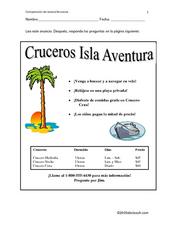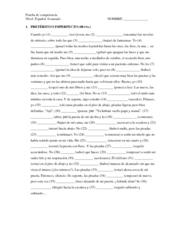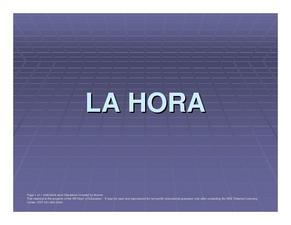Curated OER
El subjuntivo con expresiones de emoción
The subjunctive is used in different cases. Introduce your Spanish speakers to the subjunctive when it's used to indicate emotion. There's a helpful chart that introduces the expressions of emotions and a short practice activity that...
Curated OER
Color the Turkey!
Celebrate the season! Your elementary Spanish learners will love coloring in this turkey prior to Thanksgiving Day. Each part of the turkey has a designated color, but learners must match up the number associated with each part with its...
Curated OER
My Schedule/ Mi Horario
A great opportunity for oral and written practice! Split your class into pairs, giving each of the two members a different classroom schedule (provided here). Then the beginning Spanish speaker must ask their partner a series of...
Curated OER
El Tiempo Pretérito
What tense do you use to express actions that both began and ended in the past? El tiempo pretérito, of course! Review this reference guide with your beginning Spanish speakers to provide them with the basic information for forming the...
Curated OER
Cruceros Isla Aventura
Take your Spanish speakers on an island adventure cruise! First, they read a flyer for a cruise company and answer the short-answer questions that follow. Then, they complete the prewriting activity before writing a solid paragraph to...
Curated OER
Planets in the Solar System
Explore the planets with your young Spanish speakers. First, read Los Planetas by Chris Jaeggi. Then create a class solar system using different size balls as planets. They'll love helping you put it together!
Pimsleur
Silly Family Trees
Introduce family vocabulary and practice with a sample family tree. If you're doing this lesson in class, consider showing the learners your own family tree as a model. Then have each learner create their own family tree. Post these...
Curated OER
Los participios irregulares: el presente perfecto
Looking for a reference guide to equip your learners with as they explore the irregular past participles in the perfect tense? First there's a chart that contains 12 irregulars and their meaning, and then there are example sentences to...
Curated OER
¿Qué hora es? What time is it?
This is a great reference guide for your middle and high schoolers learning how to tell time in Spanish. There are no practice opportunities provided, so consider pairing this with an exercise to get your learners using the...
Curated OER
El tiempo presente de los verbos -ar
What a great worksheet on -ar verbs in the present tense! First, study the chart provided. Then, complete the second chart with the four different verbs provided. Finally, complete the sentences with the correct form of the -ar verb...
Curated OER
¡Me Encanta el 4 de Julio!
Let's celebrate! Have your beginning Spanish learners read the short paragraph about a boy and his family's Fourth of July tradition. There are five reading comprehension questions that follow, and a vocabulary matching activity. A great...
Curated OER
Irregular Formal Commands
After learning the regular formal commands for the Spanish language, your linguists should learn the irregular formal commands. First, they complete the chart with select irregular verbs like ir, caber, and caer. Then, in the second...
Curated OER
Adjetivos Posesivos-Possessive Adjectives Explanation
This reference guide gives a great explanation for possessive adjectives. The examples are provided both in Spanish and in English, and the information is organized in bullet points and a chart. Pair this handout with a practice activity...
Curated OER
Numbers in English and Spanish!;
Let's count! Your young language learners will learn numbers one through 10 with this 10-page packet. Each page is dedicated to one number, and learners practice saying the number, tracing it, spelling it, and then writing it in Spanish.
Curated OER
Answering Questions in Spanish
Although you'll have to search the database for the accompanying handout, this resource could easily stand alone. Your Spanish speakers are starting to gain comfort in asking and answering questions. First they read the question in its...
Curated OER
The Uses of Estar
What a fantastic resource! This six-page handout details the uses of the verb estar. The first three pages explain the uses of the verb and give examples for each use. The fourth page shows a list of 32 adjectives that change...
Curated OER
Prueba de competencia
Need to know the level of your incoming Spanish class? Use this with your high school classes (or older) to determine how much Spanish they know. The quiz itself is almost six pages long and covers verb conjugation, different verb...
Curated OER
Verb Conjugation Chart
Give your beginning Spanish speakers practice conjugating different verbs by printing out this chart. It can be used for any four verbs, or you could cut the sheet in four to create a bell-ringer or exit slip activity.
Curated OER
La Hora
Present this to your beginning Spanish scholars to teach them how to tell time in the target language. The first three slides offer examples to try together, and then there are several opportunities for learners to practice either as a...
Curated OER
Direct Object Pronouns
What is a direct object pronoun and how do you use one? After looking at several examples, give your Spanish speakers an opportunity to practice. Can they place the direct object pronoun correctly in the sentence provided? Two separate...
Curated OER
¡Cha cha en Chihuahua!
Can you name all of the Mexican states? Most Americans can't, even though Mexico is our close neighbor. Encourage your Spanish learners to research a Mexican state and create a comprehensive PowerPoint to share the newly acquired...
Curated OER
Reflexive Verbs
A verb is reflexive when the subject and the object are the same. After introducing your intermediate Spanish speakers to some of the most common reflexive verbs, assign them this sheet for practice. First, they write the reflexive...
Curated OER
Present Progressive Tense
Practice the present progressive tense with three different exercises. In the first, simply take the infinitive and put it in the present progressive tense. Next, correctly conjugate the verb in parentheses so that the sentence makes...
Curated OER
Que hora es? What time is it?
How is telling time in Spanish different from telling time in English? This reference guide doesn't provide any practice opportunities, but it has clear, bulleted information, and several examples are provided. Reinforce the information...

























